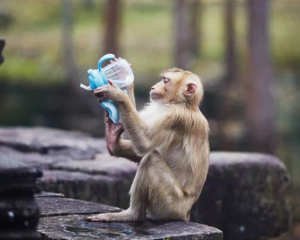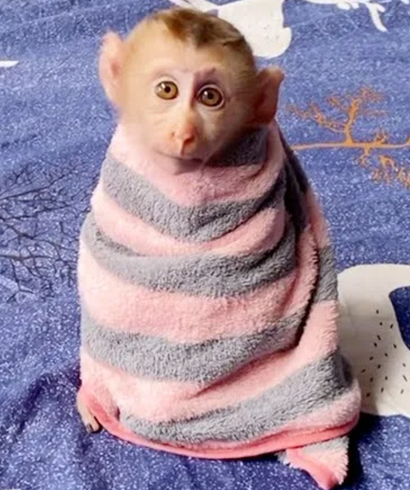
Northern Pigtail Macaque (Macaca leonina) is a species of Old World monkey found in South and Southeast Asia. These monkeys are known for their distinctive pigtail-like tail, from which they derive their name. They are part of the Cercopithecidae family, which includes other macaque species.
Physical Appearance
The Northern pigtail macaque has a robust body with a relatively short tail that curves like a pig’s tail, giving it its name.
Adult males are significantly larger than females. Males typically weigh between 15 to 20 kilograms (33 to 44 pounds), while females weigh about 8 to 12 kilograms (18 to 26 pounds).
Their fur is usually brown or grayish-brown, with lighter underparts. They have a dark cap of fur on the top of their head and lighter fur around their face.
Their facial skin is usually pinkish or flesh-colored, with some darker pigmentation around the eyes.
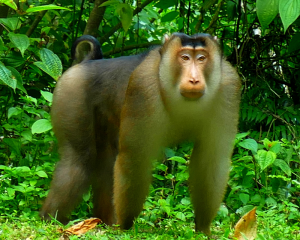
Behavior
Northern pigtail macaques are diurnal and primarily arboreal but can also be seen on the ground, especially when foraging for food.
They live in multi-male, multi-female groups called troops, which can vary in size from a few individuals to over 30 members. The social structure is hierarchical, with a clear dominance ranking among males and females.
Males often leave their natal group upon reaching maturity, while females typically remain with their birth group for life.
They communicate using a variety of vocalizations, facial expressions, and body postures to convey information about social status, threats, and emotions.
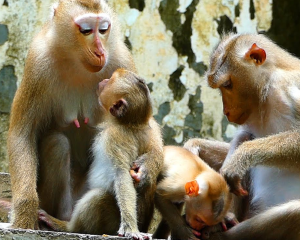
Habitat
Northern pigtail macaques inhabit a range of forested environments, including tropical and subtropical rainforests, deciduous forests, and sometimes in human-altered landscapes like plantations.
They are found across several countries in South and Southeast Asia, including northeastern India, Myanmar, Thailand, Laos, Cambodia, Vietnam, and southern China.
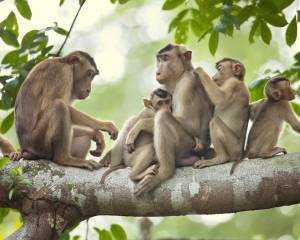
Diet
These macaques are omnivorous, with a diet that includes fruits, seeds, leaves, insects, small vertebrates, and other plant materials.
They are known to raid crops, which can sometimes lead to conflicts with humans. In some areas, they are considered pests due to their tendency to forage in agricultural fields.

Conservation Status
The Northern pigtail macaque is currently listed as “Vulnerable” on the International Union for Conservation of Nature (IUCN) Red List.
The primary threats to their survival are habitat loss due to deforestation and agricultural expansion, hunting for bushmeat and the pet trade, and conflicts with humans due to crop raiding.
Conservation Efforts
Conservation measures for the Northern pigtail macaque include habitat protection, anti-poaching efforts, and education programs to reduce human-wildlife conflicts.
Some populations live within protected areas, but enforcement of hunting and habitat protection laws is often limited.
Research on the species’ ecology, behavior, and population dynamics is ongoing to better inform conservation strategies.
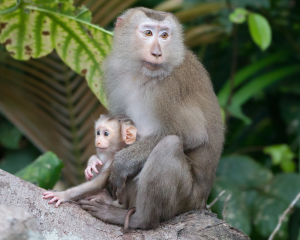
Interesting Facts
Northern pigtail macaques are intelligent animals known for their problem-solving skills and ability to adapt to different environments. In captivity, they have been observed using tools, such as using sticks to extract insects from crevices.
Human Interaction:
Due to their adaptability, Northern pigtail macaques are sometimes seen in urban areas or near human settlements. However, this can lead to negative interactions, such as crop raiding or aggressive behavior towards people when they become habituated to human presence.
Role in Ecosystems:
These macaques play an important role in their ecosystems as seed dispersers. By consuming fruits and defecating the seeds in different locations, they help maintain forest diversity and regeneration.
Northern pigtail macaques are fascinating primates with complex social structures and behaviors. Despite their adaptability, they face numerous threats in the wild, making conservation efforts essential to ensure their survival.
